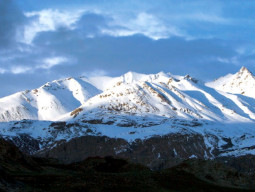
In districts Thatta and Sujawal, tehsils like Kharo Chann, Jati, Shah Bunder and Keti Bunder Taluka are adjacent to the Arabian Sea. In Keti Bunder Taluka, 32 out of 42 settlements have been engulfed by the intruding sea and the only reason is the shortage of fresh water and the rise in sea level.
We are eyewitnesses to the more than 25 years of a mature and thick mangrove forest, which has been disappearing over a period of time, due to different reasons, like shortage of fresh water, overgrazing by camels and cutting of trees by local communities for firewood. Moreover, mangrove forests are also known to be the walls that protect coastal areas from storms and cyclones, as well as the hatchery for fish and shrimps.
Locals in these coastal areas reveal that they are always vulnerable to cyclones and storms due to the depleting mangrove forests, which do not only protect them, but also provide livelihoods by being a source of firewood and fish. Hassan Alias Gilli Solani, the president of a community-based organisation, shared that mangroves have been planted adjacent to a village in Khobar Creek with the support of the World Wide Fund for Nature under its Indus for All Programme during the year 2008.
Experts reveal that the Avicenna Mari (commonly known as gray mangrove or white mangrove, is a species of mangrove trees classified in the plant family Acanthaceae. As with other mangroves, it occurs in the intertidal zones of estuarine areas) is one of the most dominant mangrove species in Keti Bunder. Locals also tried the almost extinct Rhizophora Mucronata (it is a species of mangroves found on the coasts and river banks in the Indo-Pacific region) with only 500 saplings and this has shown tremendous results within just five years.
It is, however, hard to maintain these mangroves as they are threatened by the grazing of camels — found across the coast in hundreds. But the efforts of community-based organisations have ensured the mangroves’ safety from camels.
“We are happy to have these mangroves grown up as dense patch that will not only protect us from the cyclones but it will also provide a lot of fish and shrimps for our livelihood,” shared Gilli, happy to see these amazing results.
These amazing results of a small demo have been shared with the Sui Southern Gas Company (SSGC), which supported this endeavour and was pleased to see its success. The SSGC plans to invest more in the area under its corporate social responsibility programme. Those leading the mangroves venture have also planned to scale up this plantation with a focus on the Rhizophora Mucronata variety of mangrove.
Published in The Express Tribune, February 23rd, 2014.
Like Opinion & Editorial on Facebook, follow @ETOpEd on Twitter to receive all updates on all our daily pieces.
COMMENTS (4)
Comments are moderated and generally will be posted if they are on-topic and not abusive.
For more information, please see our Comments FAQ




















1713904359-0/burn-(1)1713904359-0-270x192.webp)













1713853507-0/MalalaHilary-(2)1713853507-0-270x192.webp)







The local communities may be mobilized by enhancing awareness on the significance of mangroves for livelihood and by persuading the local people to take responsibility for conserving mangroves. In other parts of the world, Community Based Organisations (CBOs) have been established and their capacities enhanced through various training programmes to initiate conservation and development activities in the area.
I suggest that the Govt. of Sindh, may chalk-out a program with the active participation of local communities and the local governments of Thatta and Badin and save the coastal area, which is disappearing at a very fast pace, and intruding the agricultural land of Sindh. An inability to stop this intrusion might destroy the natural habitat of the area
Creation of awareness of the deforestation that goes on in our coastal belt and in our mountains must continue. As you have pointed out, due to reduced water flows from the Indus to the Delta, the effect to our coastline and marine life and the resulting harm to the livelihoods of coastal fishing communities is tragic. Deforestation in other areas of Pakistan has led to Pakistan having one of the lowest tree covers in the world. Another disaster is destroying mangroves for purpose of urban development- case in point is the Mai Kolachi bypass where the KPT has already taken over and cut down the mangroves, parcelled off the land and sold it. The other side of the Mai Kolachi are still there, just about. In Sandspit, mangroves were cut down by the land mafia and the reclaimed land sold off- Abdul Ghani a local fisherman and his colleague were drowned by the land mafia for trying to save these mangroves. Karachi is one of the unique cities of the world that has natural mangrove forests in the city centre and we must try and save this God given gift to us.
These people should make way for nation building.